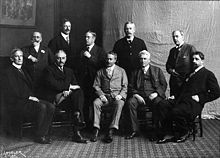User:Clutter1/sandbox

The Ten American Painters was formed in 1898 to exhibit their artwork as a unified group. Among the many members of the society was John Henry Twachtman, who was dissatisfied with the conservative nature of the artists he was surrounded by- and in turn decided to accept the title of impressionism. J. H. Twachtman, J. Alden Weir, and Childe Hassam were the real driving forces behind the organization, determined to create their own exhibition that valued originality, imagination, and exhibition quality. The three artists decided that they had had enough of the conservative nature of the other societies, and decided to do what many before them had already done. In order to create a new group, they had to recruit new members; most from the East Coast (places like Boston and New York City) in order to keep the exhibits together. The public took very well to The Ten, and their exhibits became spectacles of American artistry for all of the years that the group was active. As well as displaying their artwork to the public, The Ten published exhibition guides with footnotes about each painting as well as the artist who painted it.[1]
In America, popular painting styles were generally distributed and produced from the east coast in cities like New York and Boston. In 1877, the Society of American Artists was formed as a group for established painters to meet and exhibit their work as a collective. The society was seen as a very conservative group, and the idea of accepting something as radical as impressionism was immediately frowned upon. Leaving the group was considered a bold move by the general public, but the Society of American Artists felt that it was easier to appease the members that were leaving, and just let them go. The Ten American Painters (also known as The Ten) was born from this group. For twenty years, The Ten would hold exhibitions throughout New York and Boston, where it's members would show off their art work to the public (the most being Impressionism-like work). Throughout the time that the group was active, it was decided that there would never be less than ten members active. Eventually, the group dissolved due to death of the members and lack of public interest.[2]
Members
[edit]Frank W. Benson, Joseph R. DeCamp, Thomas Wilmer Dewing, Childe Hassam, Willard L. Metcalfe, Robert Reid, Edward Simmons, Edmund C. Tarbell, and J. Alden Weir, were all members of The Ten alongside Twachtman- and all were former members of the Society of American Artists. After J. H. Twachtman died in 1902, William Merritt Chase joined The Ten in his place. In order for a new member to join the society, the members (as a whole) would have had to unanimously decide to accept the artist into their ranks. Each of these artists were contemporary impressionist painters and used the group to display their art work.[2]
Impressionism
[edit]Impressionism is one of the best examples of European art- or art in general. Painters like Monet and Degas are generally considered the masters of the impressionist movement. An Impressionism painting will often be likened to placing small dabs of color in order to make the painting distinguishable from afar, but indistinguishable from up close. Impressionism was a French movement that came to be around the 19th century, but was quickly picked up by American painters towards the end of the 19th century and into the early 20th century. Prior to the American impressionist movement, painters "repelled" the idea of impressionism; many calling the style radical, giving the thought that the artist had no natural talent. This however proved to be untrue because of the vast stylistic decisions that an artist could make to the work of art.[3]
Breakdown of Societies
[edit]American art history is a vast subject, and over the years the societies that house all of the artists have shifted and changed with the times. Mainly all of the societies were created out of each other by members of each one that were dissatisfied with how they were being run. In the beginning, there was the American Academy of Fine Arts, then that turned into the National Academy of Design, to the Society of American Artists, to the Ten American Painters. The Ten American Painters eventually dissolved after twenty years of exhibitions due to the death of many of the members, so many artists then turned back to the National Academy of Design. The Society of American Artists was eventually dissolved into the National Academy of Design.
References
[edit]- ^ “Ten American Painters: The First Exhibition, Catalogue of the Pictures, from the Thomas Wilmer Dewing and Dewing Family Papers - Image and Media Gallery | Archives of American Art, Smithsonian Institution.” Accessed September 16, 2015. http://www.aaa.si.edu/collections/items/detail/ten-american-painters-first-exhibition-catalogue-pictures-14281.
- ^ a b Brockett, Erik. "The Ten American Painters". Antiques & Fine Art Magazine. Retrieved 10 September 2015.
- ^ “Impressionism.” Accessed September 21, 2015. http://www.artmovements.co.uk/impressionism.htm.
Category:American artist groups and collectives Category:American Impressionism Category:19th-century American painters Category:20th-century American painters Category:Modern art Category:Cultural history of the United States

